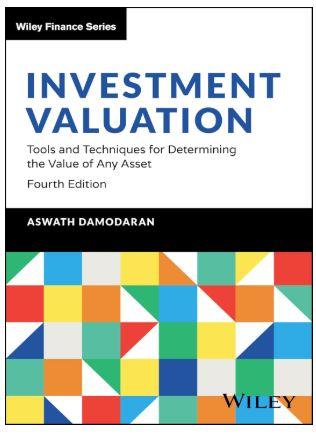Wiley
Investment Valuation: Tools and Techniques for Determining the Value of Any Asset, 4th Edition
Investment Valuation: Tools and Techniques for Determining the Value of Any Asset, 4th Edition
Couldn't load pickup availability
Author: Aswath Damodaran
ISBN: 9781394254606
December 2024
1136 pages
Hardcover
Wiley
Description:
Updated edition of the definitive guide to investment valuation tools and techniques
Investment Valuation: Tools and Techniques for Determining the Value of Any Asset delves into valuation techniques for a variety of different asset classes, including real options, start-up firms, unconventional assets, distressed companies and private equity, real estate, and many more, and explains how to choose the right model for any given asset valuation scenario. The models are presented with real-world examples so as to capture some of the problems inherent in applying these models, with discussion of differences and common elements between the models to provide readers with a holistic understanding of the subject matter.
Written by a professor of finance who is widely regarded as one of the best educators and thinkers on the topic of investment valuation, this newly revised and updated Fourth Edition explores topics including:
- Understanding financial statements, the basics of risk, and tests and evidence for market efficiency
- Estimating risk parameters and costs of financing, terminal value, and equity value per share
- Using scenario analysis, decision trees, and simulations for probabilistic approaches in valuation
Investment Valuation: Tools and Techniques for Determining the Value of Any Asset is an essential resource for all investors and students of financial markets seeking an all-in-one guide to expand their valuation knowledge and make better investment decisions.
Table of Contents:
Preface xv. Chapter 1 Introduction to Valuation. A Philosophical Basis for Valuation. Pricing versus Valuation. The Bermuda Triangle of Valuation. Market Efficiency. The Role of Valuation. Conclusion. Questions and Short Problems. Chapter 2 Approaches to Valuation. Intrinsic Valuation. Pricing or Relative Valuation. Contingent Claim Valuation. Conclusion. Questions and Short Problems. Chapter 3 Understanding Financial Statements. The Basic Accounting Statements. Asset Measurement and Valuation. Measuring Financing Mix. Measuring Earnings and Profitability. Measuring Risk. Other Issues in Analyzing Financial Statements. Conclusion. Questions and Short Problems. Chapter 4 The Basics of Risk. What Is Risk?. Equity Risk and Expected Return. Alternative Models for Equity Risk. A Comparative Analysis of Equity Risk Models. Models of Default Risk. Conclusion. Questions and Short Problems. Chapter 5 Option Pricing Theory and Models. Basics of Option Pricing. Option Pricing Models. Extensions of Option Pricing. Conclusion. Questions and Short Problems. Chapter 6 Market Efficiency—Definition, Tests, and Evidence. Market Efficiency and Investment Valuation. What Is an Efficient Market?. Testing Market Efficiency. Cardinal Sins in Testing Market Efficiency. Some Lesser Sins That Can Be a Problem. Evidence on Market Efficiency. Time Series Properties of Price Changes. Market Reaction to Information Events. Market Anomalies. Evidence on Insiders and Investment Professionals. Conclusion. Questions and Short Problems. Chapter 7 Riskless Rates and Risk Premiums. The Risk-Free Rate. Equity Risk Premium. Default Spreads on Bonds. Conclusion. Questions and Short Problems. Chapter 8 Estimating Risk Parameters and Costs of Financing. The Cost of Equity and Capital. Cost of Equity. From Cost of Equity to Cost of Capital. Best Practices at Firms. Conclusion. Questions and Short Problems. Chapter 9 Measuring Earnings. The Lead-in: From Accounting Data to Financial Information. Adjusting Earnings. Measuring Earnings Power: Clean Up and Time Differences. Conclusion. Questions and Short Problems. Chapter 10 From Earnings To Cash Flows. The Tax Effect. Reinvestment Needs. Conclusion. Questions and Short Problems. Chapter 11 Estimating Growth. The Importance of Growth. Historical Growth. Outsourcing Growth. Fundamental Determinants of Growth. Top-Down Growth: From Revenue Growth to Free Cash Flows. Qualitative Aspects of Growth. Conclusion. Questions and Short Problems. Chapter 12 Closure in Valuation: Estimating Terminal Value. Closure in Valuation. The Survival Issue. Closing Thoughts on Terminal Value. Conclusion. Questions and Short Problems. Chapter 13 Narrative and Numbers – Story to Value. Valuation as a Bridge. The Importance of Storytelling. The Dangers in Storytelling. From Story to Numbers: The Process. Narrative and Numbers Across the Life Cycle. Story Resets, Changes, and Breaks. Conclusion. Questions and Short Problems. Chapter 14 Equity Intrinsic Value Models. Equity Valuation. The Dividend Discount Model. The Augmented Dividend Discount Model. Potential Dividend or FCFE Models. FCFE Valuation Versus Dividend Discount Model Valuation. Conclusion. Questions and Short Problems. Chapter 15 Firm Valuation: Cost of Capital and Adjusted Present Value Approaches. Free Cash Flow to the Firm. Firm Valuation: The Cost of Capital Approach. Firm Valuation: The Adjusted Present Value Approach. Firm Valuation: Sum of the Parts. Effect of Leverage on Firm Value. Conclusion. Questions and Short Problems. Chapter 16 Estimating Equity Value per Share. Value of Nonoperating Assets. Firm Value and Equity Value. Stock-based Compensation. Value Per Share When Voting Rights Vary. Conclusion. Questions and Short Problems. Chapter 17 Fundamental Principles of Relative Valuation. Use of Relative Valuation. Standardized Values and Multiples. Four Basic Steps to Using Multiples. Reconciling Relative and Discounted Cash Flow Valuations. Conclusion. Questions and Short Problems. Chapter 18 Earnings Multiples. Price-Earnings Ratio. The PEG Ratio. Other Variants on the PE Ratio. Enterprise Value to EBITDA Multiple. Conclusion. Questions and Short Problems. Chapter 19 Book Value Multiples. Price-to-Book Equity. Value-to-Book Ratios. Tobin’s Q: Market Value/Replacement Cost. Conclusion. Questions and Short Problems. Chapter 20 Revenue Multiples and Sector-Specific Multiples. Revenue Multiples. Sector-Specific Multiples. Conclusion. Questions and Short Problems. Chapter 21 Valuing Financial Service Firms. Categories of Financial Service Firms. What Is Unique About Financial Service Firms?. General Framework for Valuation. Discounted Cash Flow Valuation. Relative Valuation. The Crisis Effect. Nonbank Financial Service Firms. Conclusion. Questions and Short Problems. Chapter 22 Valuing Money-Losing Firms. Negative Earnings: Consequences and Causes. Valuing Money-Losing Firms. Conclusion. Questions and Short Problems. Chapter 23 Valuing Young or Start-Up Firms. Information Constraints. General Framework for Analysis. Value Drivers. Estimation Noise. The Expectations Game. Conclusion. Questions and Short Problems. Chapter 24 Valuing Private Firms. What Makes Private Firms Different?. Estimating Valuation Inputs at Private Firms. Valuation Motives and Value Estimates. Valuing Venture Capital and Private Equity Stakes. Pricing Private Businesses. Conclusion. Questions and Short Problems. Chapter 25 Acquisitions and Takeovers. Background on Acquisitions. Steps in an Acquisition. Takeover Valuation: Biases and Common Errors. Structuring the Acquisition. Improving the Odds. Analyzing Management and Leveraged Buyouts. Conclusion. Questions and Short Problems. Chapter 26 Valuing Real Estate. Real Versus Financial Assets. Real Estate: The Underfollowed Investment Class. Intrinsic Valuation of Real Estate. Comparable/Relative Valuation. Valuing Real Estate Businesses. Conclusion. Questions and Short Problems. Chapter 27 Valuing Other Assets. Investment Classification. Cash-Flow–Producing Assets. Collectibles. Trophy Assets. Conclusion. Questions and Short Problems. Chapter 28 The Option to Delay and Valuation Implications. Real Options: Promise and Pitfalls. The Option to Delay a Project. Valuing a Patent. Natural Resource Options. Other Applications. Conclusion. Questions and Short Problems. Chapter 29 The Options to Expand and to Abandon: Valuation Implications. The Option to Expand. When Are Expansion Options Valuable?. Valuing a Firm with the Option to Expand. Valuing the Optionality in Users and Data. Value of Financial Flexibility. The Option to Abandon. Reconciling Net Present Value and Real Option Valuations. Conclusion. Questions and Short Problems. Chapter 30 Valuing Equity in Distressed Firms. Equity in Highly Levered Distressed Firms. Optionality in Valuation: A Corporate Life Cycle Perspective. Implications of Viewing Equity as an Option. Estimating the Value of Equity as an Option. Distressed Equity as an Option: Consequences for Decision-Making. Conclusion. Questions and Short Problems. Chapter 31 Value Enhancement: A Discounted Cash Flow Valuation Framework. Value-Creating and Value-Neutral Actions. Ways of Increasing Value. Value Enhancement Chain. Closing Thoughts on Value Enhancement. Conclusion. Questions and Short Problems. Chapter 32 Value Enhancement: Economic Value Added, Cash Flow Return on Investment, and Other Tools. Economic Value Added. Cash Flow Return on Investment. A Postscript on Value Enhancement. Conclusion. Questions and Short Problems. Chapter 33 Probabilistic Approaches in Valuation: Scenario Analysis, Decision Trees, and Simulations. Scenario Analysis. Decision Trees. Simulations. An Overall Assessment of Probabilistic Risk-Assessment Approaches. Conclusion. Questions and Short Problems. Chapter 34 Overview and Conclusion. Choices in Valuation Models. Which Approach Should You Use?. Choosing the Right Intrinsic Valuation Model. Choosing the Right Pricing Model. When Should You Use the Option Pricing Models?. Conclusion. References. Index.
Author's LinkedIn Profile: Aswath Damodaran is a Professor of Finance at NYU's Stern School of Business. His professional profile can be found on the NYU Stern website: pages.stern.nyu.edu
Links to International Organizations Related to Investment Valuation:
- International Organization of Securities Commissions (IOSCO): Provides principles for valuation of collective investment schemes.
- Organisation for Economic Co-operation and Development (OECD): Offers insights into global investment policies.
- United Nations Conference on Trade and Development (UNCTAD): Publishes the World Investment Report focusing on foreign direct investment trends.
- World Bank – Investment Climate: Provides support to countries to foster an investment-grade business environment.
-
Keywords: Investment Valuation, Asset Valuation, Financial Analysis, Corporate Finance, Risk Assessment, Equity Valuation, Real Options, Private Equity, Distressed Assets, Aswath Damodaran
-
Target Audiences: Finance Professionals, Investment Analysts, Business Students, Financial Advisors, Corporate Finance Managers
-
Genres: Finance, Investment, Business, Educational, Professional Development


